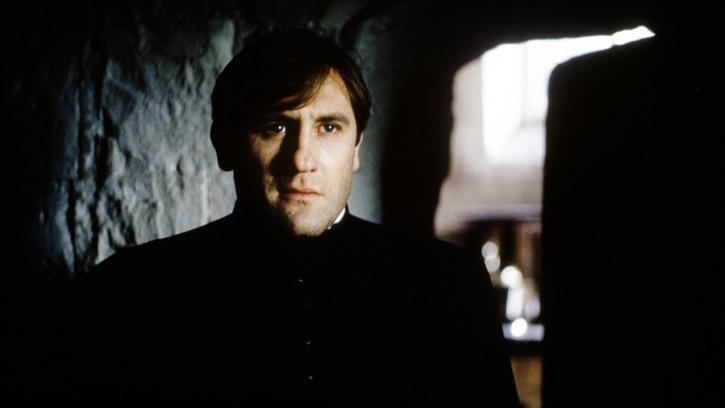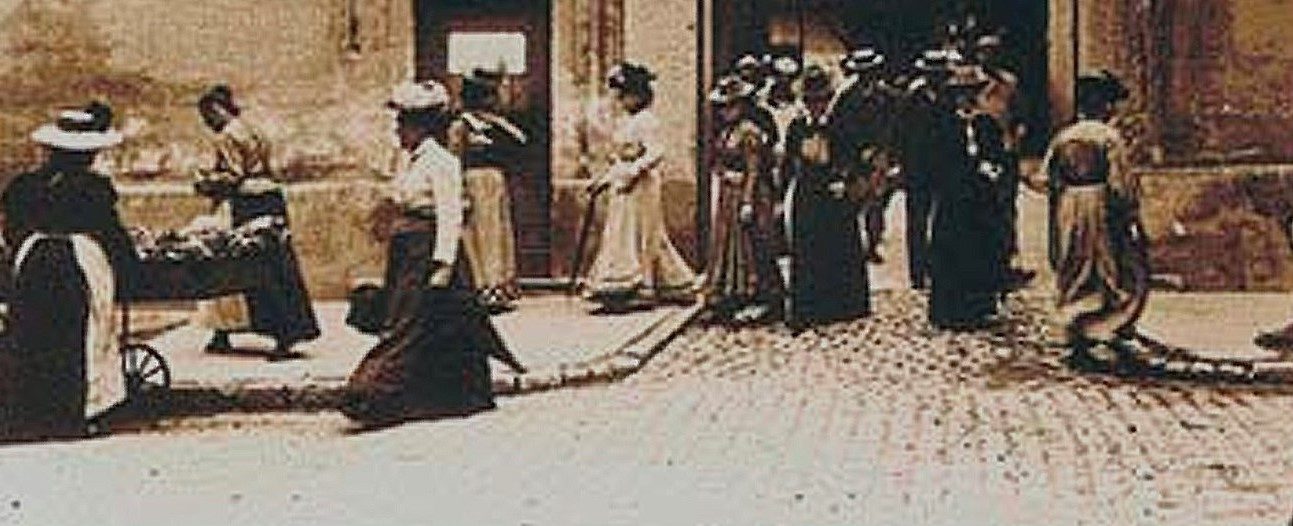France, 1987
Directed by Maurice Pialat
With Gérard Depardieu (Donissan), Maurice Pialat (Menou-Segrais), Sandrine Bonnaire (Germaine Malhorty, aka Mouchette), Jean-Christophe Bouvet (the horse trader/Satan)

The story is divided into four parts, boldly altering and editing the contents of the eponymous novel by French writer Georges Bernanos. The first depicts the lead character through his discussions with his mentor. Donissan is a priest living in a corner of northern France at the onset of the 20th century; a strapping young man from a poor background, he has struggled to graduate from the seminary and self-doubt rips him apart; mortification and endless self-criticism dangerously weaken his body and his soul. That really saddens Menou-Segrais, the priest who has taken Donissan under his wing, and who keeps thinking that God has anointed the tormented youngster to become a remarkable priest.
The second part relates the tragic life of another young person living in the vicinity, the daughter of a businessman, Germaine Malhorty, also known as Mouchette, in a sudden change of topic, though still in a somber mood. The girl’s rebellious streak, her awareness of the sexual desire she elicits, and her stubborn anger at social rules make her a troublemaker and an unstable character. She kills by accident, or perhaps out of mischief, one of her two lovers, a marquis, and teases, or perhaps threatens, the other one, a doctor who is also the local deputy. She reckons to run away but instead drifts around the area.
Then the third part puts the focus back on Donissan and firmly brings the movie into spiritual and supernatural territories. As he walks in the countryside to go to another parish, Donissan gets lost and at the end of the night meets a shabby horse trader; he turns out to be an incarnation of Satan, who intends to shake the priest’s faith. Donissan thinks he has won the confrontation but realizes he has acquired a dubious talent. When he stumbles across Mouchette, he clearly knows what she has done and what she thinks and tries to convince her of God’s power. True to her nature, she mocks the cleric and rejects his help. A few hours later, however, she commits suicide. Coming out of nowhere, Donissan tries to save her, but when it is obvious she is dead, he carried her in his arms to the church, causing a huge scandal. He is dismissed from his position and sent away in a convent.
Years later, he has become in charge of a small parish. His flocks see him as a saint; as it happens, he does make a miracle, bringing back to life a kid who has died from meningitis. But Donissan fears his feat should be put down to Satan’s tricks and not to God’s will and he feels more distraught and dejected than ever. A heart failure kills him as Menou-Segrais is paying a visit to his parish.
The first two sections are audaciously though abruptly linked by an extraordinary cut: the camera has captured every gesture of Donissan as he gives the communion to the attendants of a mass but freezes on his face as his eyes suddenly stare at a point on his right side and off-screen; then Mouchette, whose eyes also look to her right, appears, ambling in a corridor as badly lit as the church. The montage thus hints at Donissan’s future concern about the promiscuous girl and puts her story in the wake of the priest’s torments, in a full reversal of Bernanos’ narrative. Both parts share the same emphasis on long takes, filmed in medium shots and with few effects, which focus on the long, sophisticated dialogues that pit both youngsters to elders. Both move awkwardly inside spaces ill-fitted for them: Donissan seems trapped inside the cramped interiors of the presbytery where Menou-Segrais lives while the bourgeois homes of her lovers jar with Mouchette’s distrust of conventions and thirst for spontaneity. The movie clearly asserts the priest and the girl are stubborn personalities who are related by a deep sense of insecurity; Donissan thinks he is unworthy while Mouchette fears being unloved.
But there is still a huge difference: temptation may be lurking around the priest but evil has already poisoned the girl’s life. However ready Donissan is to help her, he is bound to fail, the topic of the third part which essentially gives his adventures a wider, cosmic dimension. His encounter with Satan (which is shot in a blueish atmosphere and played by a smartly-controlled, down-to-earth manner that spares us any outrageous search for performance or fantastic thrill) is framed by long shots on Donissan plodding along first the streets of the small town and then the paths of a majestic rural landscape; the man, who clearly provokes mixed reactions from the population, becomes a black smudge on a vibrant green canvas. This greenery remains the stage of the dramatic, emphatically played, battle of wills between Donissan and Mouchette that follows, and which eventually leads to the stunning episode inside the church. In a way, this episode graphically emphasized how misdirected Donissan’s zeal is, but also prepares the ground for the last part and points to the trial Satan has seemingly designed for him.
There is a remarkable narrative ellipsis between the third part and the last one, as it is the case in the book but the appearance of Mouchette’s ghost allows them to be linked, even as things have turned around for Donissan, who leads now a modest clerical career his flocks would rather consider a fine example of sainthood. But the priest remains a tortured soul, even more wildly than before: this time the camera catches him speaking to himself aloud and, unlike the previous the episodes, his eyes look straight into the eye of the camera oftener and oftener, with his paler and paler face haunting the audience till the brutal end, shot in a magnificent chiaroscuro. It is striking to watch how the narration gains both momentum in this last part of a religious tragedy; the pieces of the narrative the mise en scène has shaped fall into place and lead to the heartbreaking picture of a rock-solid body ruled by a passionate spirit collapsing under the fight between good and evil and light and shades.
The carefully conceived imagery and plot guide the audience to the core of “Sous le soleil de Satan” and help them appreciate what turns out to be its success: making plain, vivid, the intensity of the soul, the force, whether it is emotional, spiritual or intellectual, that stirs the characters and their actors into action. The demanding and risky choice of a highly literary and ponderous prose for the cast’s lines, instead of feeling awkward (though it may sound like an irritant to some), rather bolsters the specificity and lyricism of the two youngsters at the center of the story, clearly articulated as the struggle of a man yearning for an all-powerful faith under the glare of Satan. This painstakingly crafted intensity and the trouble it stokes can be fully shared and felt, with an impact lasting well after the end of the film.

